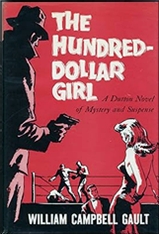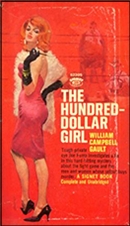Wed 12 Nov 2025
A 1001 Midnights PI Review: WILLIAM CAMPBELL GAULT – The Hundred-Dollar Girl.
Posted by Steve under 1001 Midnights , ReviewsNo Comments
by Bill Pronzini
WILLIAM CAMPBELL GAULT – The Hundred-Dollar Girl. PI Joe Puma #6. Dutton, hardcover, 1961. Signet S2205, paperback, 1962.

Sports — in particular football, boxing, and golf — play strong roles in many of Gault’s mysteries. Ex-jock Brock Callahan solves pro-football-related crimes in Day of the Ram and Dead Hero (1963). One non-series book, Fair Prey (1956), published under the pseudonym Will Duke, has a golfing background; another, The Canvas Coffin (1953), deals with the fight game and has a boxer protagonist. The Hundred-Dollar Girl likewise deals with the seedy world of professional prizefighting.
This novel is also the seventh and last to feature Gault’s other series character — and second private eye -Joe Puma. Puma is tougher than Callahan, more of a loner, but imbued with the same human qualities; Anthony Boucher wrote of him, “He is big and muscular and can give and take punishment; he drinks and wenches and has his own ideas about professional ethics. But Gault has created him so firmly and skillfully that he is a man and not a pornographic puppet … an understandable and not too happy man, sometimes likable, sometimes exasperating and always real.”
Puma made his first appearance in a pseudonymous book — Shakedown (1953), as by Roney Scott — but it wasn’t until 1958 that he emerged in full style; his first two major cases, End of a Call Girl and Night Lady, were published that year by Fawcett Crest, and three others followed in 1959-60. The Hundred-Dollar Girl is Puma’s only hardcover appearance.

Hired by Terry Lopez to keep her young boxer husband from being forced by his unscrupulous manager, Gus Galbini, to throw a fight, Puma is almost immediately plunged into a murder investigation when Galbini turns up dead. Galbini’s wife also hires him: She has special reasons for wanting to find out who killed her meal ticket.
A variety of hoodlums and beautiful women complicate matters and lead Puma on a perilous course to the (surprising) identity of Galbini’s killer. The Dutton edition’s dust jacket blurb calls this “a story of violence and death at ringside, replete with action and color and full of the authentic atmosphere of life in the ring and life in the underworld.” For once, dust jacket blurb is not only accurate but justified in its praise.
Gault also brought Joe Puma back in The Cana Diversion,but he brought him back dead: The central premise of that novel is Brock Callahan’s search for Puma’s murderer. Those of us who liked Big Joe as well as we like Callahan, if not more so, may never quite forgive Bill Gault for so cold-bloodedly knocking him off.
———
Reprinted with permission from 1001 Midnights, edited by Bill Pronzini & Marcia Muller and published by The Battered Silicon Dispatch Box, 2007. Copyright © 1986, 2007 by the Pronzini-Muller Family Trust.